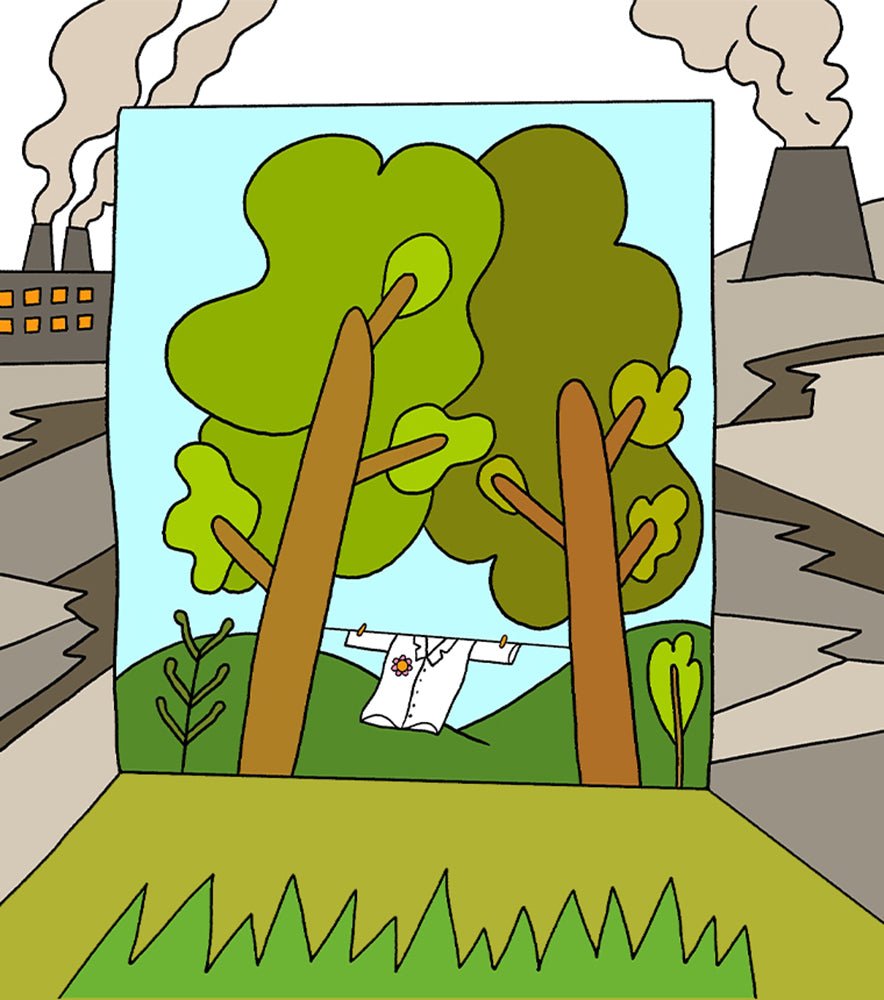Sustainability sells well. Companies that care more about sales than about the environment also know this. A popular marketing strategy is therefore to present one's own products and their impact as greener, more beautiful and greater than is actually the case - or, to put it briefly, to practice greenwashing.
It is interesting to note that it is not only large corporations that use these tricks. It is also companies that give the impression of striving for an improvement for the planet out of honest conviction. How can consumers keep track of who to believe?
The first signs of greenwashing can be a lack of evidence, vague statements or, quite simply, green-looking packaging. It is worth taking a critical look here. Terms that sound like a lot but mean little are preferably used: non-protected terms such as "organic" or "biological". Only the word "organic" is certified, the other terms have little informative value.
The words "climate-neutral" or "climate-positive", which are also used in advertising by sustainable fashion labels such as Armed Angels or Organic Basics, are not protected either. But what exactly does that mean?
The path to climate neutrality
To achieve climate neutrality, a company's emissions are calculated and ideally reduced accordingly. However, it is never possible to eliminate all emissions. Many companies therefore try to compensate for this surplus by donating to CO2-reducing projects. Anyone who has flown in recent years is already familiar with this principle: by donating to reforestation projects in the rainforest or the construction of biogas plants in Kenya, you can buy your way out of your own flight shame.
What is particularly questionable about this form of modern indulgence trading, however, is that some companies skip the step of reducing their own emissions. Instead, they pay directly to offset projects to compensate for their emissions. So the cause of the problem is not even addressed, instead only the symptoms are tackled. Another point of criticism is that the results of the emissions calculations depend heavily on the methodology used and the available data basis. It is therefore unclear whether all the emissions emitted by a company are actually recorded.1
Furthermore, the question arises as to how much sense the CO2-saving projects actually make. These so-called compensation projects can also go wrong. Let's take the example of reforestation: Trees that have been planted may not grow or may burn down.2 A reforested forest is more susceptible to forest fires, drought and pests than a forest that has grown slowly and naturally. "This means that there is a risk that the forest will quickly be destroyed again and the bound CO2 will be released."A CO2 sink effect is thus always only temporary." 3
The capitalisation of CO2
This would mean that although CO2 would have become less on paper, in reality there would have been no impact. Moreover, according to studies, many of these projects would have been implemented even without an offset investment: "Some projects were implemented years ago and accounted for afterwards, or emissions were artificially pushed up in advance. Offset projects thus rarely lead to emissions being saved, but often to people in the Global South being further patronised by industrialised countries." 4
This is yet another flip side of the purchased climate neutrality: Through compensation projects, "entrenched patterns of capitalism, colonialism and patriarchy are perpetuated." 5 They are already leading to land grabbing and displacement in many countries.6 This favours the perpetuation of colonial structures. Those who can afford it - primarily Western countries and their populations - buy the right to consume CO2. The measures to save are taken where they themselves are not, and where people are already suffering the first noticeable consequences of climate change.7
By degrading the environment to a commodity, the compensation system creates further inequalities. "A lot of money is earned with the awarding and regular verification of certificates. As a result, mostly smaller companies often cannot afford to be certified as a climate-neutral company, for example, even though they meet all the criteria." 8
A lingering doubt
This in turn requires consumers to look closely - as with the fair fashion brands Armed Angels and Organic Basics mentioned at the beginning. Both brands provide comprehensive, well-founded reports on how they calculate their emissions and what measures they take to offset them. If no precise information is available, greenwashing can be suspected.9
In order to make things easier for consumers, the first court rulings have now been issued which stipulate that "companies that advertise with the term must make transparent how they have achieved climate neutrality. The Wettbewerbszentrale, a German trade association, had filed a lawsuit against some companies. This is a start." 10
Nevertheless, the goal of climate neutrality leaves us in doubt. It prioritises greenhouse gases over other aspects to be protected such as biodiversity, clean air and water, but also over health, gender justice and resource conservation.11 It remains questionable "how sensible it really is to make every area of life, no matter how damaging to the climate, climate neutral - to want to compensate for every piece of meat with trees. The first scientists are already warning that there is not enough space in the world for all the trees and forests that are supposed to absorb the CO2 that the world wants to compensate for in the coming decades." 12 The most sensible solution remains to consume as little as possible.
1 https://klima-der-gerechtigkeit.de/2020/04/22/die-risiken-der-klimaneutralitaet-weshalb-die-derzeitigen-umsetzungsversuche-den-prinzipien-der-klimagerechtigkeit-widersprechen/
2 https://fashionchangers.de/wie-nachhaltig-ist-klimaneutral-oder-klimapositiv/
3 https://www.freitag.de/autoren/guido-speckmann/klimaneutralitaet-gibt-es-nur-auf-dem-papier
4 ibid.
5 ibid.
6 https://werde-magazin.de/blog/2021/07/05/imeh-ituen-ich-wuensche-mir-radikale-demokratische-loesungen/
7 https://klima-der-gerechtigkeit.de/2020/04/22/die-risiken-der-klimaneutralitaet-weshalb-die-derzeitigen-umsetzungsversuche-den-prinzipien-der-klimagerechtigkeit-widersprechen/
8 https://fashionchangers.de/wie-nachhaltig-ist-klimaneutral-oder-klimapositiv/
9 ibid.
10 https://www.zeit.de/2021/53/klimaneutralitaet-co2-ausgleich-unternehmen-greenwashing
11 https://www.freitag.de/autoren/der-freitag/klimaneutralitaet-gibt-es-nur-auf-dem-papier
12 https://www.zeit.de/2021/53/klimaneutralitaet-co2-ausgleich-unternehmen-greenwashing
Text: Kathrin Weins
Illustration: © Tanya Teibtner
